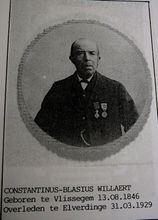Family tree Jacobs » Emilius Augustus Willaert (1882-1882)
Personal data Emilius Augustus Willaert
- He was born on January 26, 1882 in Vlissegem.
- He died on June 17, 1882 in Vlissegem.
- A child of Constantinus Blasius Willaert and Elisabeth Francisca Bienstman
- This information was last updated on August 27, 2007.
Household of Emilius Augustus Willaert
Timeline Emilius Augustus Willaert
This functionality is only available in Javascript supporting browsers.
Click on the names for more info.
Symbols used:  grandparents
grandparents
 parents
parents
 brothers/sisters
brothers/sisters
 children
children
 grandparents
grandparents
 parents
parents
 brothers/sisters
brothers/sisters
 children
children
Ancestors (and descendant) of Emilius Augustus Willaert
Emilius Augustus Willaert | ||||||||||||||||||
The data shown has no sources.
Matches in other publications
This person also appears in the publication:Historical events
Birthday January 26, 1882
- The temperature on January 26, 1882 was about -3.8 °C. The air pressure was 1 kgf/m2 and came mainly from the south-southeast. The airpressure was 78 cm mercury. The atmospheric humidity was 95%. Source: KNMI
- Koning Willem III (Huis van Oranje-Nassau) was from 1849 till 1890 sovereign of the Netherlands (also known as Koninkrijk der Nederlanden)
- In The Netherlands , there was from August 20, 1879 to April 23, 1883 the cabinet Van Lijnden van Sandenburg, with Mr. C.Th. baron Van Lijnden van Sandenburg (conservatief-AR) as prime minister.
- In the year 1882: Source: Wikipedia
- The Netherlands had about 4.5 million citizens.
- March 2 » Queen Victoria narrowly escapes an assassination attempt by Roderick McLean in Windsor.
- March 4 » Britain's first electric trams run in east London.
- March 24 » Robert Koch announces the discovery of Mycobacterium tuberculosis, the bacterium responsible for tuberculosis.
- March 29 » The Knights of Columbus is established.
- June 28 » The Anglo-French Convention of 1882 marks the territorial boundaries between Guinea and Sierra Leone.
- December 16 » Wales and England contest the first Home Nations (now Six Nations) rugby union match.
Day of death June 17, 1882
- The temperature on June 17, 1882 was about 16.2 °C. The air pressure was 1 kgf/m2 and came mainly from the southwest. The airpressure was 76 cm mercury. The atmospheric humidity was 61%. Source: KNMI
- Koning Willem III (Huis van Oranje-Nassau) was from 1849 till 1890 sovereign of the Netherlands (also known as Koninkrijk der Nederlanden)
- In The Netherlands , there was from August 20, 1879 to April 23, 1883 the cabinet Van Lijnden van Sandenburg, with Mr. C.Th. baron Van Lijnden van Sandenburg (conservatief-AR) as prime minister.
- In the year 1882: Source: Wikipedia
- The Netherlands had about 4.5 million citizens.
- April 3 » American Old West: Robert Ford kills Jesse James.
- May 20 » The Triple Alliance between the German Empire, Austria-Hungary and the Kingdom of Italy is formed.
- June 30 » Charles J. Guiteau is hanged in Washington, D.C. for the assassination of U.S. President James Garfield.
- July 11 » The British Mediterranean Fleet begins the Bombardment of Alexandria in Egypt as part of the Anglo-Egyptian War.
- July 26 » Premiere of Richard Wagner's opera Parsifal at Bayreuth.
- July 26 » The Republic of Stellaland is founded in Southern Africa.
Same birth/death day
- 1877 » Kees van Dongen, Dutch painter († 1968)
- 1878 » Dave Nourse, English-South African cricketer and coach († 1948)
- 1880 » Douglas MacArthur, American general, Medal of Honor recipient († 1964)
- 1885 » Harry Ricardo, English engineer and academic († 1974)
- 1885 » Michael Considine, Irish-Australian politician († 1959)
- 1885 » Per Thorén, Swedish figure skater († 1962)
- 1839 » Lord William Bentinck, English general and politician, 14th Governor-General of India (b. 1774)
- 1866 » Joseph Méry, French poet and author (b. 1798)
- 1889 » Lozen, Chiracaua Apache warrior woman (b. ~1840)
- 1898 » Edward Burne-Jones, English soldier and painter (b. 1833)
- 1904 » Nikolay Bobrikov, Russian soldier and politician, Governor-General of Finland (b. 1839)
- 1936 » Julius Seljamaa, Estonian journalist, politician, and diplomat, Estonian Minister of Foreign Affairs (b. 1883)
About the surname Willaert
- View the information that Genealogie Online has about the surname Willaert.
- Check the information Open Archives has about Willaert.
- Check the Wie (onder)zoekt wie? register to see who is (re)searching Willaert.
The Family tree Jacobs publication was prepared by Michael Jacobs.
When copying data from this family tree, please include a reference to the origin:
Michael Jacobs, "Family tree Jacobs", database, Genealogy Online (https://www.genealogieonline.nl/stamboom-michael-jacobs/I64007.php : accessed April 30, 2025), "Emilius Augustus Willaert (1882-1882)".
Michael Jacobs, "Family tree Jacobs", database, Genealogy Online (https://www.genealogieonline.nl/stamboom-michael-jacobs/I64007.php : accessed April 30, 2025), "Emilius Augustus Willaert (1882-1882)".
